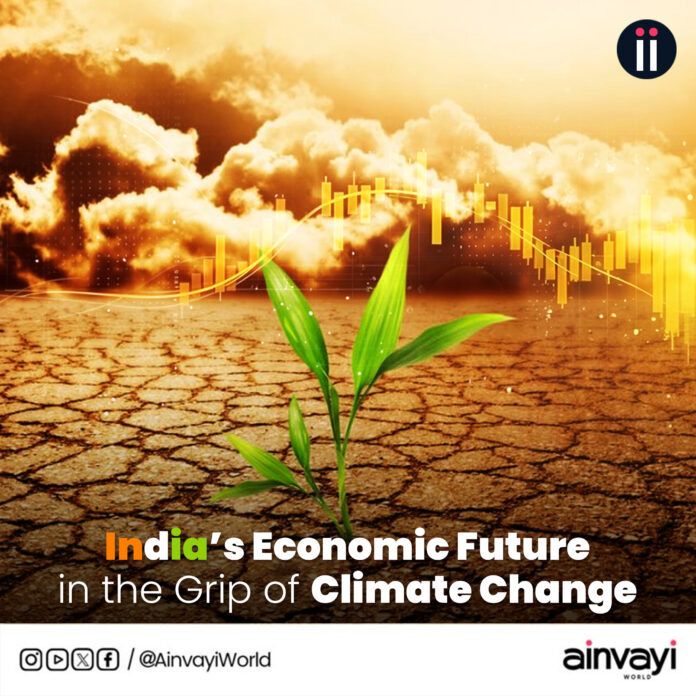As the global climate crisis deepens, its impact on India’s economy in 2024 is becoming increasingly evident. The effects of climate change extend beyond environmental shifts, permeating nearly every aspect of life. Let’s explore the multifaceted ways climate change is reshaping India’s economic landscape.
- Sector-Specific Impacts
Agriculture and Rural Livelihoods
India’s economy relies heavily on agriculture, making it particularly vulnerable to climate change. Erratic weather patterns—including unseasonal rainfall, cloudbursts, prolonged droughts, and intense heatwaves—are disrupting crop cycles, reducing yields, and degrading crop quality. The rural population, which constitutes a significant portion of India’s workforce, faces multiple hardships: health problems due to extreme weather, dwindling incomes as agricultural output declines, and mounting debts. Tragically, the high rate of farmer suicides highlights the severity of the crisis. Many farmers are compelled to switch to alternative, climate-resilient crops, altering not only traditional farming practices, but also their lifestyles, and diets. Allied sectors such as animal husbandry, dairy, fisheries, and poultry farming are also grappling with the effects of climate change, as extreme conditions and emerging diseases take a toll on the health of livestock. This shift not only exacerbates rural economic distress but also drives increased migration to urban areas, further straining city infrastructure and resources.
Water Resources
Water is a critical resource for many industries, and climate change is leading to increased water scarcity and degrading water quality in several parts of India. This not only affects agriculture but also industries such as textiles, manufacturing, and food processing, all of which depend heavily on water for their operations. It may also lead to geopolitical tensions between states, compounding the challenges. In regions facing prolonged droughts, businesses are forced to spend more on securing water supplies, which increases production costs and can lead to supply shortages. Moreover, the rising costs associated with water scarcity and water purification contribute to inflationary pressures on essential goods, further straining household budgets and increasing economic inequality. The financial burden of ensuring water availability—through infrastructure investments like desalination plants or more efficient irrigation systems—will ultimately fall on both the public and private sectors. In the long term, scarcity and contamination of water could hinder India’s industrial growth and exacerbate rural-urban migration, creating labor shortages in certain sectors and overcrowding in urban areas, which already struggle with infrastructure demands.
Energy and Power
India’s energy sector faces significant challenges from climate change. The country remains highly dependent on thermal and hydro power plants, but rising temperatures and evolving needs increase energy demand, especially for cooling. This puts strain on the existing energy infrastructure, resulting in higher operational costs. For example, heatwaves push up demand for electricity to power air conditioning systems, creating spikes in energy consumption that often lead to blackouts and additional strain on the power grid. Simultaneously, the transition to renewable energy sources like solar and wind—though necessary and gradually gaining momentum—requires considerable investment in new infrastructure—such as solar parks, wind farms, and improved energy storage solutions—while also managing the decline of fossil fuel-based industries. As India seeks to balance energy security with climate action, businesses must navigate increasing costs and regulatory pressures.
Infrastructure and Urban Development
India’s infrastructure, particularly in metropolitan cities and urban centers, is highly vulnerable to climate change. Rising sea levels and extreme weather events, such as floods and cyclones, pose significant threats to buildings, roads, and bridges, leading to high repair and maintenance costs. The increasing frequency of such events puts additional pressure on urban planners to invest in climate-resilient infrastructure, significantly driving up development costs. These expenses are ultimately borne by the public. During heatwaves, for instance, there is a surge in demand for air conditioning and private transportation, while impurities in water and air necessitate the purchase of purifiers. Additionally, residents are burdened with rising taxes to fund essential infrastructure improvements.
Automobile
The automobile sector in India is facing significant challenges as climate change drives a shift toward sustainable transportation. Increasing temperatures and extreme weather events are prompting a greater focus on personal vehicles, hybrid and electric vehicles, as well as public transportation solutions. As urban areas grapple with pollution and traffic congestion, the demand for greener alternatives is rising. However, the transition requires substantial investment in infrastructure, such as charging stations for EVs and incentives for consumers. Automakers must innovate and adapt to these changes, balancing economic viability with environmental responsibilities.
Healthcare
The healthcare sector is facing rising costs as climate change contributes to the emergence and spread of health issues linked to increasing temperatures, pollution, and extreme weather events. These health issues, on the rise, place significant pressure on both public and private healthcare systems. The expenses associated with treating climate-related conditions have started to strain budgets, raise insurance premiums, and jeopardize the financial stability of families. This situation underscores the urgent need for more hospitals, medical staff, and medical schools, alongside updates to medical training. Also, there is a pressing demand for more research and development into climate-related health issues, and the availability of affordable medicines targeting these. A growing trend of wellness & meditation centers, and the integration of traditional healthcare practices with modern approaches is helping people cope with climate-related challenges. As the healthcare sector navigates these complexities, effectively addressing the impacts of climate change will be crucial for safeguarding public health and maintaining economic stability.
Financial Sector
Banks and financial institutions are increasingly exposed to climate-related risks, particularly in terms of loan portfolios tied to sectors like agriculture, infrastructure, and insurance. As these industries confront climate challenges, the potential for defaults rises, leading to heightened investment risks. In 2024, financial institutions are somewhat beginning to recognize the need to adjust their lending models to account for these risks. However, this shift could result in reduced credit availability for vulnerable sectors, further hindering economic growth. Moreover, not all banks and financial institutions are equally sensitive to climate change-related risks and their impacts on the common man. This exacerbates financial instability for those most affected by environmental changes, leaving them at a greater disadvantage.
Tourism
India’s tourism industry, a vital pillar of the economy, is also feeling the brunt of climate change. Popular tourist destinations across the country are experiencing frequent natural disasters including floods, typhoons, and landslides. The consequences also include incidents like delayed snowfall, early snowmelt, forest fires, heatwaves, spread of diseases, water shortage, coastal erosion, and endangerment of wildlife habitats. All of these are leading to significant shifts in tourist numbers and behaviors. Moreover, overtourism in certain regions is having detrimental effects on sensitive ecosystems and cultural heritage sites. The long-term repercussions for tourism could be catastrophic, particularly for local economies that rely heavily on the seasonal influx of visitors. Additionally, the tourism sector itself contributes to climate change through activities such as construction, transportation, and various tourism-related services, generating substantial carbon footprints. Unsustainable tourist behaviors further amplify environmental degradation, negatively impacting the tourism economy.
Education
The education sector is indirectly affected by climate change, particularly in rural or disaster-prone areas. Extreme weather events can damage school infrastructure and disrupt education. Over the long term, these disruptions contribute to gaps in education, impacting the skills and knowledge of future generations. This, in turn, affects the broader economy by weakening the workforce’s potential, limiting India’s ability to innovate and compete globally.
Technology and Digital Economy
The tech sector is not immune to the effects of climate change either. As extreme weather events—such as floods, storms, and heatwaves—become more frequent, the reliability of infrastructure for internet connectivity and digitization is compromised. Such disruptions significantly affect productivity and business operations. Data centers, which are crucial for India’s booming IT sector, consume vast amounts of energy, and the rising demand for cooling during heatwaves further inflates operational costs. On a positive note, the emphasis on technology that promotes climate resilience—such as software solutions for energy efficiency and disaster management—opens new business opportunities. However, adapting to these demands necessitates substantial investment in innovation.
Retail and Consumer Goods
The retail sector, too, is impacted by climate change. Supply chain disruptions due to extreme weather events affect the availability of consumer goods, leading to higher prices for essentials like food, clothing, and household items. Furthermore, there is a growing shift toward eco-friendly products, forcing companies to innovate their product offerings and supply chains, which can lead to increased operational costs. Those that fail to adapt risk losing market share to more sustainable competitors.
Transportation and Logistics
The transportation and logistics sector, which is critical to moving goods across regions, is encountering new challenges due to climate change. Extreme weather events disrupt supply chains, increase transportation costs, and damage infrastructure. Additionally, rising fuel costs linked to climate policies and shortages are impacting logistics and delivery networks. India’s coastal shipping routes and major ports are particularly vulnerable to rising sea levels, adding to the overall risks and costs faced by this sector.
- Cross-Sectoral Impacts
Workforce Health and Productivity
Pollution and extreme temperatures, exacerbated by climate change, are silent but costly disruptors. Major metropolitan cities grapple with hazardous levels of pollution in air, land and water, leading to increased health issues. Employee absenteeism due to pollution-related illness is a growing concern, particularly in urban areas where environmental quality deteriorates rapidly. Severe pollution, waterlogging, floods, cyclones, and disease outbreaks, have even led to operational shutdowns of educational institutions and offices. This decrease in productivity, coupled with the rising healthcare burden on both employees and employers, directly affects revenues and disrupts operations across industries.
Business Operation Costs
Businesses, particularly in manufacturing, construction, and transportation, are witnessing escalating operating costs as climate-related disruptions multiply. As global temperatures rise, so do energy demands for cooling, leading to higher energy costs. Extreme weather events damage infrastructure, pushing businesses to invest more in climate-resilient buildings and operations. Simultaneously, rising insurance premiums linked to climate-related risks are straining corporate budgets, adding a financial burden on industries already grappling with climate disruptions.
Global Supply Chain Vulnerabilities
India is a key player in the global supply chain, especially in sectors like textiles, pharmaceuticals, and IT services. Climate change-induced disruptions—such as extreme weather impacting logistics or agricultural shifts causing raw material shortages—have impaired India’s ability to maintain its standing in the global marketplace. This creates ripple effects on trade balances and foreign exchange reserves, adding another layer of vulnerability to the economy.
Corporate and Investor Shifts
Amidst growing eco-consciousness, investors are now prioritizing companies that show climate resilience. In this time and age, businesses that fail to align with global climate goals face the risk of reduced foreign investments and difficulties in securing financing. Conversely, companies embracing green initiatives and committing to net-zero targets are gaining investor confidence and securing a competitive edge in global capital markets.
Sustainable Practices: Necessity or Burden?
The growing awareness around climate change has pressured public, companies and the government to adopt sustainable policies and practices. While sustainability is crucial for long-term survival, the immediate costs can be burdensome for smaller enterprises, and for some, it may not even be feasible or financially viable. Companies are now expected to invest in green technologies, energy-efficient operations, and low-carbon alternatives, which can raise operational expenses in the short term. However, businesses that fail to make this transition risk regulatory penalties and losing ground in consumer preference, especially as environmentally conscious buyers increasingly favor sustainable brands.
Economic Inequality
One of the often-overlooked consequences of climate change is the exacerbation of economic inequality. As extreme weather events, resource scarcity, and rising costs of essential goods impact various sectors, the financial burden disproportionately affects lower-income populations, particularly those in rural and vulnerable areas. While wealthier individuals and businesses can adapt by investing in climate-resilient infrastructure or switching to sustainable technologies, poorer communities lack the resources to implement these changes and continue to endure deteriorating living conditions. If left unaddressed, these growing inequalities could destabilize both local economies and the national economy as a whole.
- Government Response
Subsequent Indian governments have made significant strides in addressing climate change through initiatives like the National Action Plan on Climate Change (NAPCC) and institutions such as the National Green Tribunal (NGT). Despite these, the balancing act between economic growth and environmental sustainability remains challenging. India’s push for industrialization and urbanization potentially conflicts with its climate goals.
To address these concerns, comprehensive reforms are required—ranging from reducing carbon emissions, starting with government institutions, to encouraging the transition to renewable and sustainable alternatives, and fostering research and development. Prioritizing environmental health and improving quality of life are crucial, alongside developing and implementing robust legal frameworks, and ensuring timely grievance redressal.
The financial burden, especially on small and medium enterprises and the general public, remains a major obstacle to the widespread adoption of climate-friendly practices. However, public awareness campaigns, combined with policy incentives, can help catalyze broader engagement and drive the transition to more sustainable practices.
Ultimately, the government’s ability and genuine intent to integrate these climate priorities with economic strategies will determine how well India navigates the climate challenge and shapes its future economic landscape.
Conclusion
In 2024, India’s economy stands at a critical juncture in its battle against climate change. The need for coordinated efforts across sectors, businesses, the public and the government is more pressing than ever. It is no longer merely an environmental concern; it is an economic reality that will define India’s growth trajectory in the years to come.




